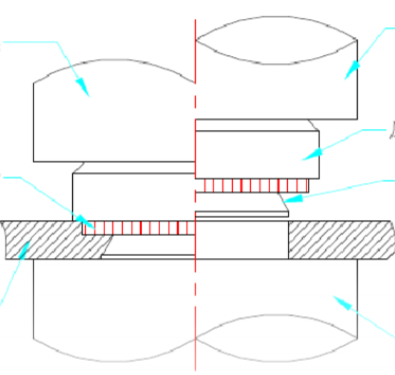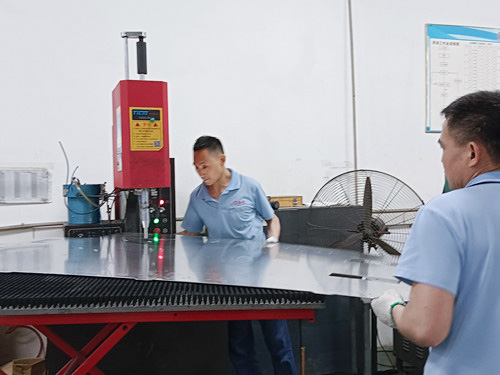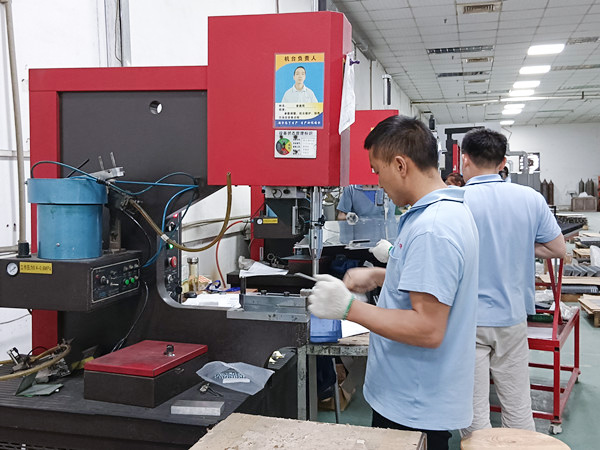Introduction of Sheet Metal Riveting Process
Riveting process: refers to a green connection method that connects nuts, screws and other materials to sheet materials by means of pressure riveting, expanding riveting, extrusion or pulling riveting.
1 Introduction of pressure riveting process
The pressure riveting process refers to a connection method in which part or all of the riveted parts are pressed into the sheet material on special equipment, using a mold and using a certain pressure.
Pressure riveting riveting parts include pressure riveting riveting parts with flower teeth and pressure riveting riveting parts without flower teeth. After the pressure riveting riveting part with flower teeth is pressed into the sheet, the rotation of the riveting part is prevented by the flower teeth embedded in the sheet material, and the torsion force of the riveting part is mainly supported; The material is used to prevent the push-out of the riveted parts, and it mainly bears the push-out force of the riveted parts. After the riveting part without flower teeth is pressed into the sheet, the hexagonal shape of the pressed part prevents the rotation of the riveting part, and mainly bears the pushing force of the riveting part. In addition, the frictional force between the riveted part and the sheet metal after riveting can also bear part of the torsion and push-out force.
FIG. 1 and FIG. 2 are schematic diagrams of the pressure riveting process of the pressure riveting riveting piece with flower teeth and the pressure riveting riveting piece without flower teeth respectively.
2 Riveting process
The riveting process refers to a connection method in which the riveted parts are partially opened by using a mold and a certain pressure on special equipment, and they are engaged with the sheet metal. The equipment used in the expansion riveting process is the same as the pressure riveting process. The upper die head used is tapered, and the pressure is used to deform the riveted part of the expansion riveting riveting piece to form a certain taper, thereby completing the connection with the riveting piece.
At present, our company's riveting riveting parts include circular riveting nuts, hexagonal rivet nuts and rivet captive screws.
The connection between the riveting part and the plate part is a deformation connection in the circumferential direction, which can bear a large push-out force, but a small torque. The hexagonal expansion rivet nut needs to have an undercut, and the torque that the expansion riveting riveting part can bear is increased by the engagement of the flower teeth or the undercut with the plate.
3 and 4 are schematic diagrams of the riveting process of the circular rivet nut and the hexagonal rivet nut, respectively.



The extrusion process refers to a connection method in which the riveted parts are partially extruded into the sheet material on special equipment, using a mold and using a certain pressure. The equipment used in the extrusion process is the same as that used in the pressure riveting process, and the surfaces of the upper and lower dies used in the extrusion process and the riveted parts and the riveted parts are flat.
The head of the extruded riveting part is a flower tooth. Through a certain pressure, the flower tooth part of the riveting part is pressed into the sheet material, and the torque and a certain pushing force are endured by the engagement of the flower tooth and the sheet material. The grooves snap into the sheet to withstand the push-out force. The difference between the extrusion riveting piece and the pressure riveting riveting piece with flower teeth and the expansion riveting riveting piece lies in the height of the flower teeth, and the height of the flower teeth with the extrusion riveting piece is larger.
The extrusion riveting part is suitable for unilateral operation, and the extrusion standoff can be used to complete the assembly when it is impossible to put the pressure riveting standoff from the back of the sheet for pressure riveting. Figure 5 is a schematic diagram of the extrusion process.
4 Introduction of riveting process
The pull riveting process mentioned in this specification refers specifically to pull rivet nuts, which are commonly called pull caps. The method of the riveting process is: using a special tool to pull the gun, through the pull gun head bolt and the internal thread of the rivet nut, the pull gun drives the head bolt to rotate, thereby driving the relative movement of the nut, causing the thin-walled area of the nut to expand and deform , until the sheet is pressed.
The rivet nut clamps the sheet material through local deformation, and can withstand a large push force and a certain torque.
Generally, there are three ways to fix screws:
1) Direct punching (through hole) or drawing hole on the plane of sheet metal parts, using self-tapping screws. The problem of screw self-tapping is better, and the problem of screw self-tapping will not occur. Only the driving force will be a little heavier than the non-triangular self-tapping screw. If a screw with a diameter of 3mm is used for locking, the hole diameter D shall be between 2.4mm and 2.5mm. If it is locked with a screw with a diameter of 4mm, the hole diameter D shall be between 3.4mm and 3.5mm.
2) Punch through hole or drawing hole on the plane of sheet metal parts, and then tap the teeth with screw tap, and tap the mechanical teeth of M3 or M4. If the screw with a diameter of 3mm is used for locking, the hole diameter D shall be 2.6mm before tapping. If a screw with a diameter of 4mm is used for locking, the hole diameter D shall be 3.6mm before tapping. If the material thickness is 1.0 ~ 1.2mm, it is recommended to adopt drawing hole instead of through hole. When tapping m3 teeth with a material thickness of 1.2mm, there are only 2.5 teeth, which is easier to slip.
3) When you punch through the hole on the plane of the sheet metal part and then rivet the self-clinching nut of the finished product, the hole diameter D of the riveting fixing nut is better than the size recommended by the manufacturer. However, when riveting nuts, it must be noted that PEM (Penn Engineering & Manufacturing Corp), a large manufacturer of stand-off / self-clinching nuts, has a special riveting machine. But they process riveting one by one, which is labor-consuming, time-consuming and money-consuming. Therefore, almost all processing plants use general punch to rivet. If the unfortunately used machine is a traditional press, the nut may fall off. The reason is that the stamping speed of the traditional stamping machine is too fast, and the material of the workpiece has no time to fill the nut or stand-off groove. No problem can be found from the appearance, but some nuts will fall off when assembling the finished product. Therefore, the machine for riveting the fixed nut is best to choose one that can adjust its stamping speed.
Machining Scope:Precision Laser Cutting, Fiber Laser Cutting, CNC Robot Bending, Riveting, Welding, Broaching, Drilling, Tapping, CNC Machining, Metal Finishing, Assembling etc.
